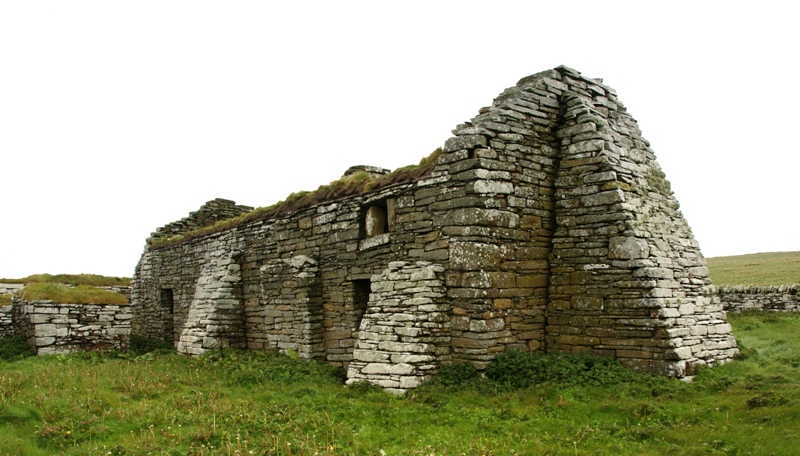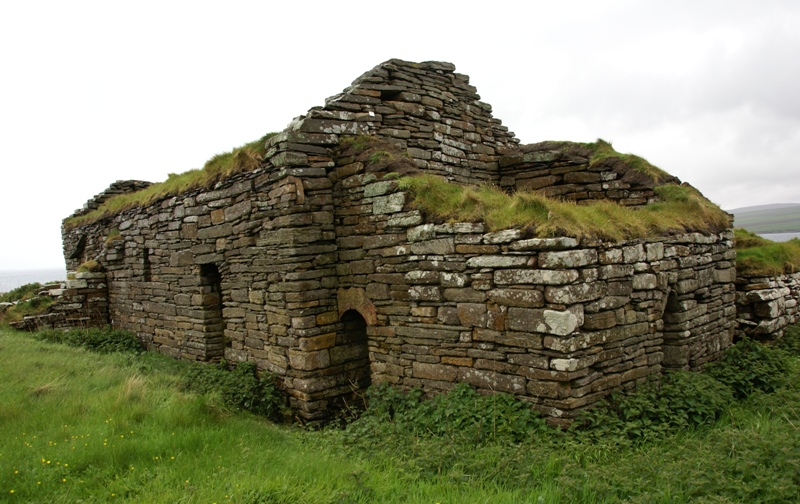Eynhallow Church on:
[Wikipedia]
[Google]
[Amazon]
 Eynhallow Church is a ruined medieval church located on the uninhabited island of
Eynhallow Church is a ruined medieval church located on the uninhabited island of
 Eynhallow as island church or monastery, was abandoned by the 16th century. The church was later modified and used as a residential dwelling. In 1851 there were 4 cottages remaining on the island. When the residents became ill, possibly due to a contaminated water supply, they were evacuated off the island. When the cottages were torn down, and the roof was pulled off one of the cottages, the foundation of the medieval church was discovered. The remains were later studied by antiquarians, T.S. Muir and Sir Henry Dryden. In 1897, the ruins were examined further by Professor T. Lethaby. In 1911 the site was placed in the guardianship of the Office of Works. Eynhallow church was first scheduled as a
Eynhallow as island church or monastery, was abandoned by the 16th century. The church was later modified and used as a residential dwelling. In 1851 there were 4 cottages remaining on the island. When the residents became ill, possibly due to a contaminated water supply, they were evacuated off the island. When the cottages were torn down, and the roof was pulled off one of the cottages, the foundation of the medieval church was discovered. The remains were later studied by antiquarians, T.S. Muir and Sir Henry Dryden. In 1897, the ruins were examined further by Professor T. Lethaby. In 1911 the site was placed in the guardianship of the Office of Works. Eynhallow church was first scheduled as a
Eynhallow Monastery
*Orkneyjar
Eynhallow - The Holy Isle
{{coord, 59, 8, 28.40, N, 3, 7, 18.20, W, display=title, type:landmark_region:GB Churches in Orkney Ruins in Orkney Historic Scotland properties in Orkney 12th-century church buildings in Scotland Church ruins in Scotland Scheduled Ancient Monuments in Orkney Former Christian monasteries in Scotland
 Eynhallow Church is a ruined medieval church located on the uninhabited island of
Eynhallow Church is a ruined medieval church located on the uninhabited island of Eynhallow
Eynhallow ( sco, Eynhallow; non, Eyinhelga; nrn, Øjinhellig) is a small, presently uninhabited island, part of Orkney, off the north coast of mainland Scotland.
Geography
Eynhallow lies in Eynhallow Sound between Mainland, Orkney and Rousa ...
in Orkney
Orkney (; sco, Orkney; on, Orkneyjar; nrn, Orknøjar), also known as the Orkney Islands, is an archipelago in the Northern Isles of Scotland, situated off the north coast of the island of Great Britain. Orkney is 10 miles (16 km) north ...
, Scotland
Scotland (, ) is a country that is part of the United Kingdom. Covering the northern third of the island of Great Britain, mainland Scotland has a border with England to the southeast and is otherwise surrounded by the Atlantic Ocean to the ...
. The church dates back to the 12th-century and is thought to have originally been a monastery
A monastery is a building or complex of buildings comprising the domestic quarters and workplaces of monastics, monks or nuns, whether living in communities or alone (hermits). A monastery generally includes a place reserved for prayer which ...
. Near the church are the building remains from a post-medieval village. Historic Environment Scotland
Historic Environment Scotland (HES) ( gd, Àrainneachd Eachdraidheil Alba) is an executive non-departmental public body responsible for investigating, caring for and promoting Scotland's historic environment. HES was formed in 2015 from the mer ...
first listed the site as a scheduled monument
In the United Kingdom, a scheduled monument is a nationally important archaeological site or historic building, given protection against unauthorised change.
The various pieces of legislation that legally protect heritage assets from damage and d ...
in 1921.
Description
The ruins of Eynhallow church are situated on a slope in southwestern Eynhallow, in Orkney, Scotland. The island lies betweenRousay
Rousay (, sco, Rousee; non, Hrólfsey meaning Rolf's Island) is a small, hilly island about north of Mainland, the largest island in the Orkney Islands of Scotland. It has been nicknamed "Egypt of the north", due to its archaeological diversit ...
and Mainland, Orkney. The site consists of a roofless 12th-century church, measuring by across. The church was later modified and was used as a residential dwelling, beginning in the 16th century.
Much of the church's original fabric is still visible. The best surviving features of the church are the walls of the porch, the gables in the nave, and the foundation of the chancel walls. The interior contains a rectangular sized nave
The nave () is the central part of a church, stretching from the (normally western) main entrance or rear wall, to the transepts, or in a church without transepts, to the chancel. When a church contains side aisles, as in a basilica-type ...
with a porch
A porch (from Old French ''porche'', from Latin ''porticus'' "colonnade", from ''porta'' "passage") is a room or gallery located in front of an entrance of a building. A porch is placed in front of the facade of a building it commands, and form ...
at its west end and a square-ended chancel
In church architecture, the chancel is the space around the altar, including the choir and the sanctuary (sometimes called the presbytery), at the liturgical east end of a traditional Christian church building. It may terminate in an apse.
Ove ...
at the east end. A tower may have later been added on top of the west porch. Several pieces of carved, red sandstone were later found in an outbuilding. To the southwest of the church is the site of a 16th-century settlement. The settlement contains the remains of at least four adjoining houses. These houses may have built upon earlier structures, possibly buildings connected with the church. The settlement is approximately by in size.
Eynhallow is normally accessible by private boat from Rousay or Mainland, Orkney
The Mainland, also known as Hrossey and Pomona, is the main island of Orkney, Scotland. Both of Orkney's burghs, Kirkwall and Stromness, lie on the island, which is also the heart of Orkney's ferry and air connections.
Seventy-five per cent of ...
. Currently (January, 2022), the site is listed as "not open to visitors due to high level masonry inspections".
History
Little is known about the history of Eynhallow Church. It may have been part of a monastery, possibly of theBenedictine
, image = Medalla San Benito.PNG
, caption = Design on the obverse side of the Saint Benedict Medal
, abbreviation = OSB
, formation =
, motto = (English: 'Pray and Work')
, foun ...
order.J. Gifford, ''The Buildings of Scotland - Highland and Islands'' (2003). Yale University Press. . Pages 299-300. It has been determined that the church was built in the 12th century. Because of the name of the island, it is likely that Eynhallow was an important religious centre.''Eyin-Helha'' is Old Norse
Old Norse, Old Nordic, or Old Scandinavian, is a stage of development of North Germanic languages, North Germanic dialects before their final divergence into separate Nordic languages. Old Norse was spoken by inhabitants of Scandinavia and t ...
for ''Holy Isle''.
 Eynhallow as island church or monastery, was abandoned by the 16th century. The church was later modified and used as a residential dwelling. In 1851 there were 4 cottages remaining on the island. When the residents became ill, possibly due to a contaminated water supply, they were evacuated off the island. When the cottages were torn down, and the roof was pulled off one of the cottages, the foundation of the medieval church was discovered. The remains were later studied by antiquarians, T.S. Muir and Sir Henry Dryden. In 1897, the ruins were examined further by Professor T. Lethaby. In 1911 the site was placed in the guardianship of the Office of Works. Eynhallow church was first scheduled as a
Eynhallow as island church or monastery, was abandoned by the 16th century. The church was later modified and used as a residential dwelling. In 1851 there were 4 cottages remaining on the island. When the residents became ill, possibly due to a contaminated water supply, they were evacuated off the island. When the cottages were torn down, and the roof was pulled off one of the cottages, the foundation of the medieval church was discovered. The remains were later studied by antiquarians, T.S. Muir and Sir Henry Dryden. In 1897, the ruins were examined further by Professor T. Lethaby. In 1911 the site was placed in the guardianship of the Office of Works. Eynhallow church was first scheduled as a monument
A monument is a type of structure that was explicitly created to commemorate a person or event, or which has become relevant to a social group as a part of their remembrance of historic times or cultural heritage, due to its artistic, his ...
by Historic Environment Scotland
Historic Environment Scotland (HES) ( gd, Àrainneachd Eachdraidheil Alba) is an executive non-departmental public body responsible for investigating, caring for and promoting Scotland's historic environment. HES was formed in 2015 from the mer ...
in 1921.
Eynhallow is considered to be an important site in Norse folklore. It is said to be the home of the Finfolk
In Orkney folklore, Finfolk (sometimes Finnfolk) are Magick shapeshifters of the sea, the dark mysterious race from Finfolkaheem who regularly make an amphibious journey from the depths of the Finfolk ocean home to the Orkney Islands. They wade, s ...
, a mysterious tribe of mythical shapeshifters
In mythology, folklore and speculative fiction, shape-shifting is the ability to physically transform oneself through an inherently superhuman ability, divine intervention, demonic manipulation, sorcery, spells or having inherited the ...
.
The island was described in the Orkneyinga Saga, an anonymous narrative of the history of the Orkney and Shetland islands. The story is told of Olaf, the foster son of Svein Asleifarson and ward of Kolbein Hruga, who was kidnapped from Eynhallow in 1155. Olaf was most likely a student at the monastery at the time.
References
External links
*''Royal Commission on the Ancient and Historical Monuments of Scotland''Eynhallow Monastery
*Orkneyjar
Eynhallow - The Holy Isle
{{coord, 59, 8, 28.40, N, 3, 7, 18.20, W, display=title, type:landmark_region:GB Churches in Orkney Ruins in Orkney Historic Scotland properties in Orkney 12th-century church buildings in Scotland Church ruins in Scotland Scheduled Ancient Monuments in Orkney Former Christian monasteries in Scotland